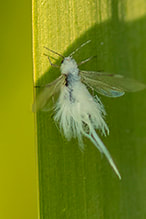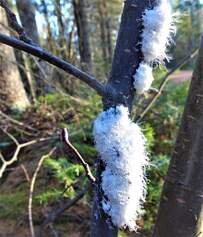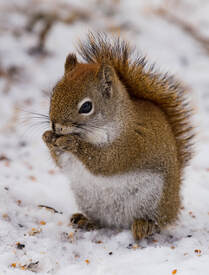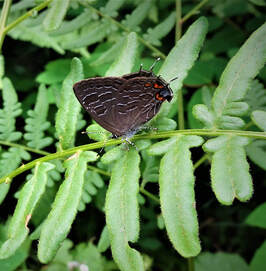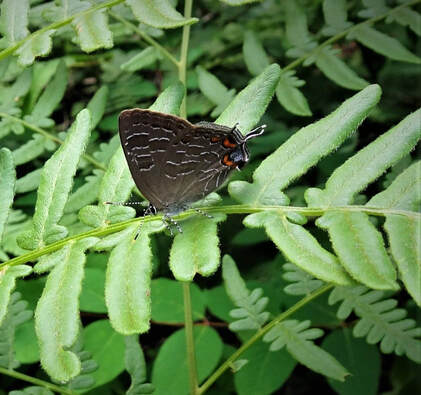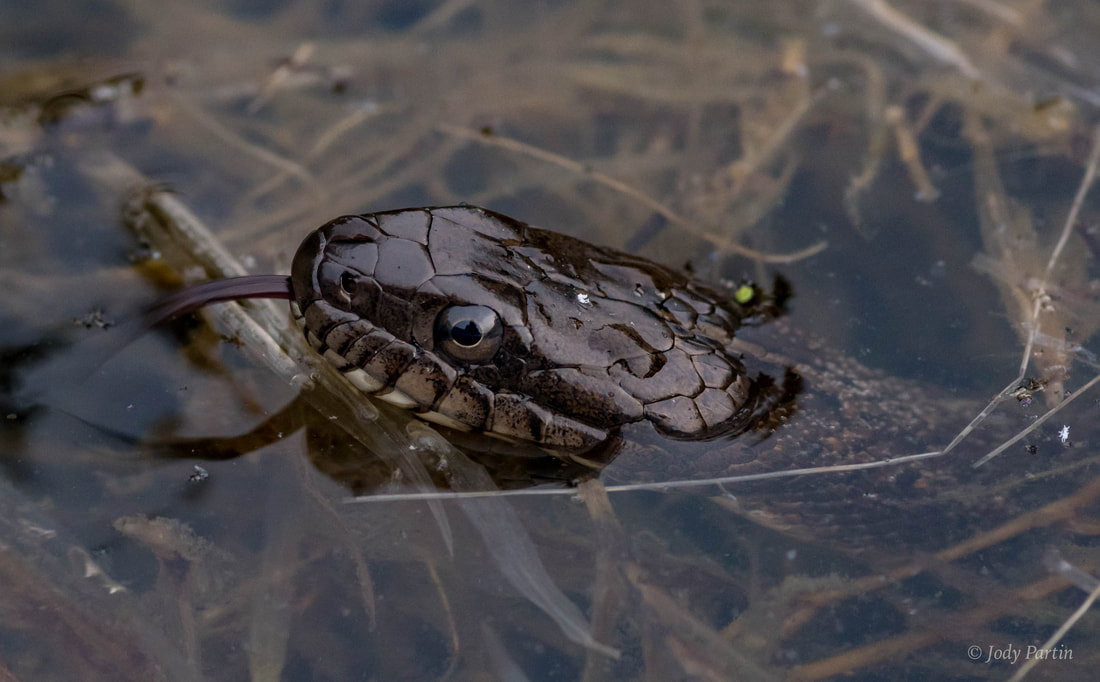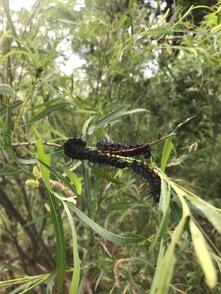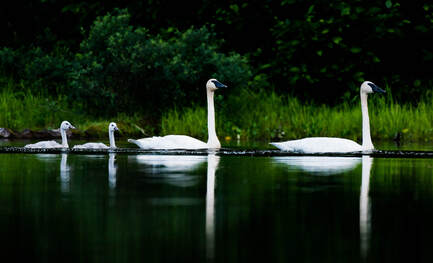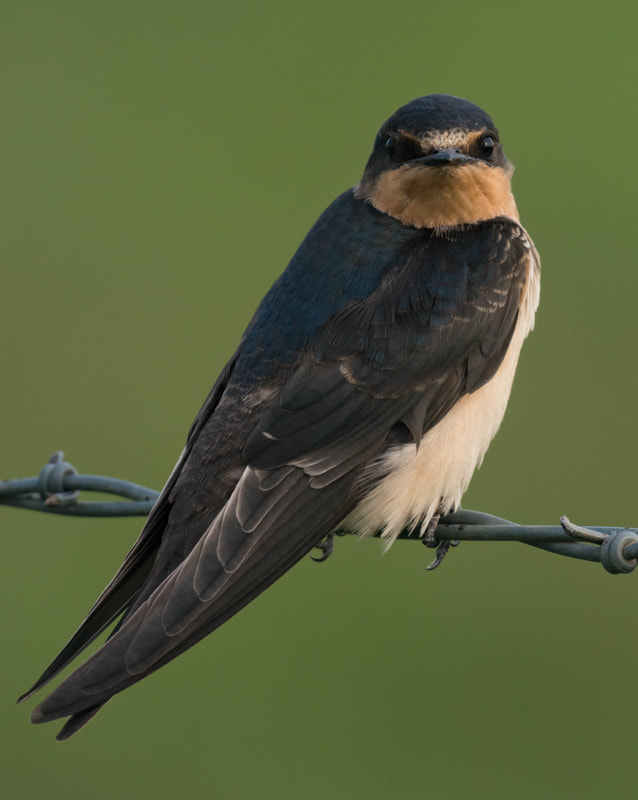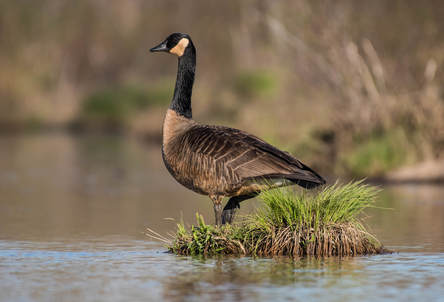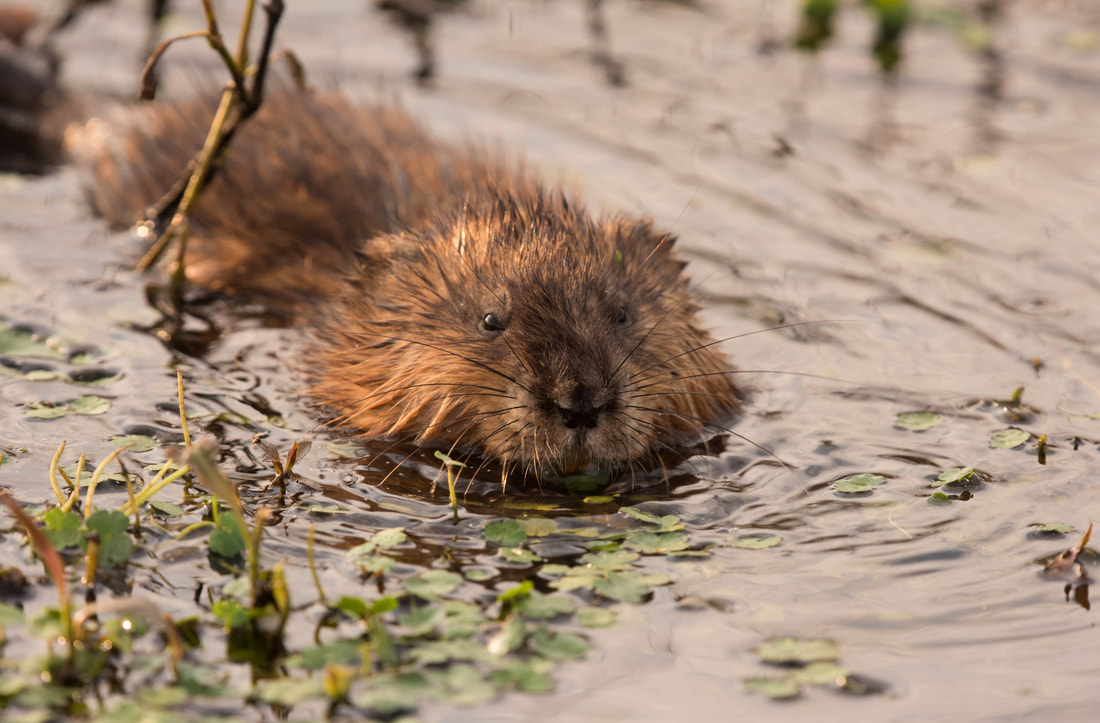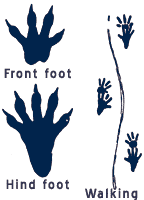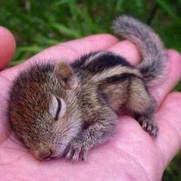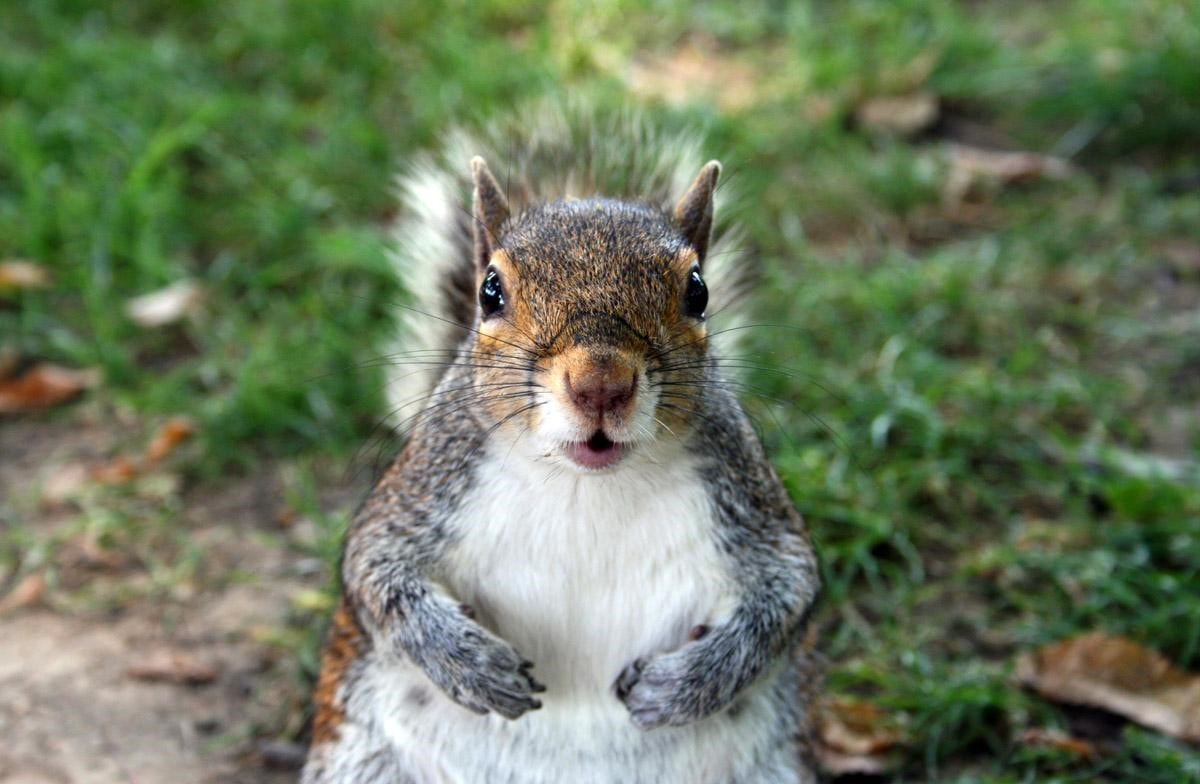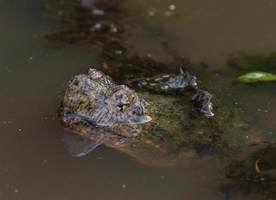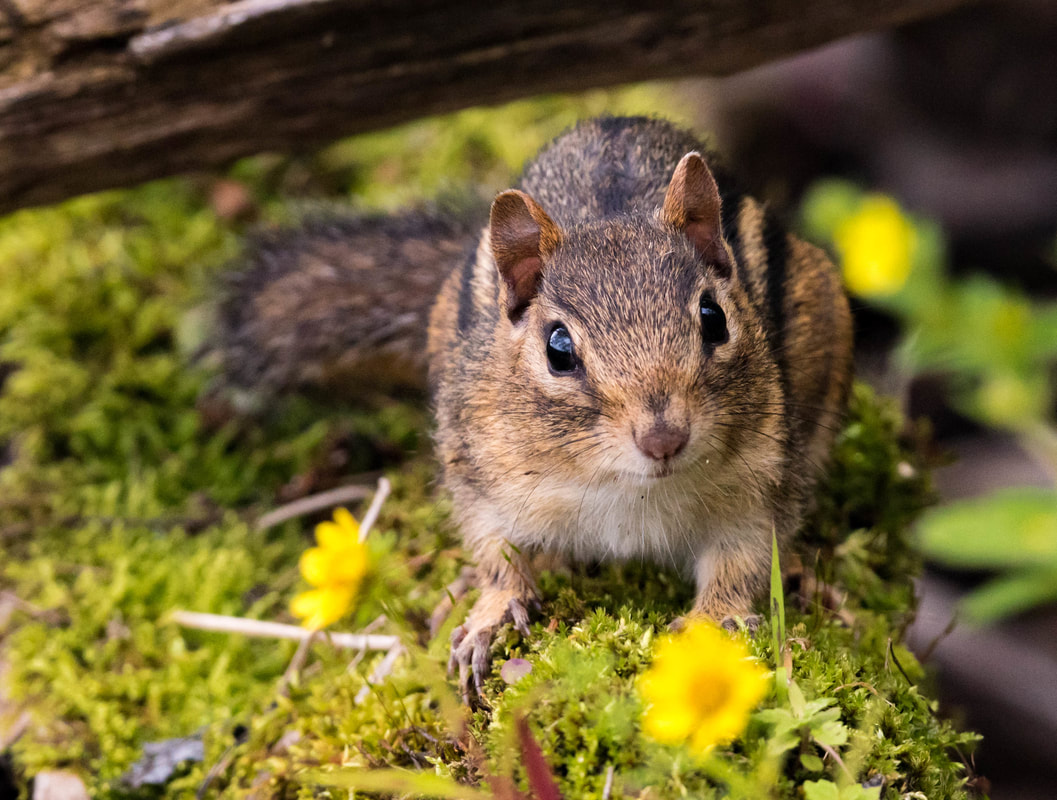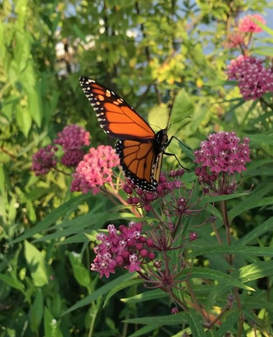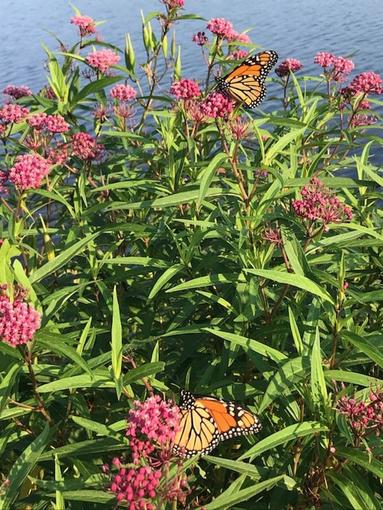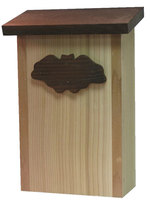Creature Feature
Updated March 14, 2024
Fishflies
|
Fishflies are members of the subfamily Chauliodinae, belonging to the megalopteran family Corydalidae. They are most easily distinguished from their closest relatives, dobsonflies, by the jaws and antennae.
Diet - Fishflies are quite large, with a wingspan of 2.5 to 3 inches. They will eat aquatic plants as well as small animals including vertebrates like minnows and tadpoles, and may live up to seven days as adults. |
|
Adult fishflies are harmless, though they can pinch. The larvae, like the closely related hellgrammites, are a good natural fish bate.
Not only are fishflies significant to the fish in the Great Lakes region, they are an important part of the food chain in general. These insects feed off algae and other energy sources in the water, which is then passed on to large fish and to the birds feeding off of them. |
Habitat and Conservation
The larvae of some fishflies prefer slow-moving, detritus-littered waters, including the edges of streams, while others require clearer, faster-flowing, better oxygenated streams. They often hide among stones. The short-lived adults are usually found among vegetation along streams. Fishfly larvae live underwater for more than two years, feeding on algae and plants and typically only come above water during the summer months to mate — and they die within days. Adult fishflies don't have mouths so they do not eat or bite people. |
Mink
|
They eat muskrats, fish, reptiles, amphibians, waterfowl, eggs and small mammals like mice. While they prefer to hunt around water bodies, they will travel and forage for food in upland habitats as well. Like all members of the weasel family, mink have delayed implantation, meaning the fertilized egg doesn't implant to the uterine wall immediately. Mink give birth in late spring to 5-6 young. Mink may be harvested during a limited, regulated season with the appropriate license.
|
Mink (Neovison vison): The mink is a semi-aquatic furbearer common throughout Wisconsin. These carnivores have short, dense, chocolate-colored fur and may have white patches on their chest and belly. Mink generally weigh 1.5-2 pounds with males being larger than females.
|
Snowshoe Hares
|
Snowshoe hares have an interesting adaptation that helps protect them against predators. Depending on the season, their fur can be a different color. During the winter, snowshoe hares are white, which helps them blend in with the snow. When the seasons change to spring and summer, snowshoe hares turn a reddish-brown. This color helps them camouflage with dirt and rocks.
|
Not every part of the snowshoe hare changes color throughout the year. An important identification trick is to look at a snowshoe hare's ears. The tips of the ears are always black no matter the season.
The hind legs of a snowshoe hare are noticeably larger, and have more fur and larger toes than those of other rabbits or hares. These adaptations provide additional surface area and support for walking on snow. The hind legs are what give the hare its common name. Snowshoe hares can be seen foraging among the brush. They eat mostly plants, enjoying grasses, flowers, and new growth from trees.
Snowshoe hares are nocturnal, so they're more likely to be seen at dawn and dusk. These animals have acute hearing and are able to detect predators.
Snowshoe hares breed in spring and summer. Females have a gestation period of roughly one month, and can give birth to up to eight young. A female hare can birth up to four litters a year.
The hares reach maturity after one year. Many hares do not live this long. But some hares can live as long as five years in the wild.
Hares and rabbits are related, but there are some key differences. Hares tend to be larger than rabbits and have longer legs and bigger ears. When threatened, rabbits typically freeze and rely on camouflage, as compared to hares, who use their big feet to flee at the first sign of danger. Rabbits are born blind and helpless, while hares are born fully furred and ready to run.
The hind legs of a snowshoe hare are noticeably larger, and have more fur and larger toes than those of other rabbits or hares. These adaptations provide additional surface area and support for walking on snow. The hind legs are what give the hare its common name. Snowshoe hares can be seen foraging among the brush. They eat mostly plants, enjoying grasses, flowers, and new growth from trees.
Snowshoe hares are nocturnal, so they're more likely to be seen at dawn and dusk. These animals have acute hearing and are able to detect predators.
Snowshoe hares breed in spring and summer. Females have a gestation period of roughly one month, and can give birth to up to eight young. A female hare can birth up to four litters a year.
The hares reach maturity after one year. Many hares do not live this long. But some hares can live as long as five years in the wild.
Hares and rabbits are related, but there are some key differences. Hares tend to be larger than rabbits and have longer legs and bigger ears. When threatened, rabbits typically freeze and rely on camouflage, as compared to hares, who use their big feet to flee at the first sign of danger. Rabbits are born blind and helpless, while hares are born fully furred and ready to run.
Short Tailed Weasel
|
The ermine looks a lot like a typical weasel, with its long body, short legs, and long neck. It’s known as the short-tailed weasel because it has a much shorter tail than its longer tailed cousin, which is aptly named - you guessed it- the long-tailed weasel.
|
They look nearly identical, with both species having reddish-brown fur on top of a white underbelly in the summer and stark white fur in the winter. They make this change so they can disappear in the snow, which makes it much easier to both hunt prey and avoid predators. The tip of their tail will remain a dark black during all seasons.
Ermine are a bit smaller than the longer tailed cousins, coming in at less than a pound and around 13 inches in length. Their tails are around a third of that length and actually aren’t that short compared to their own bodies. Females tend to be around 50% smaller than males, and they use that size to enter the homes of small prey.
Ermine are well adapted to different habitats. It prefers wooded areas near streams and often lives at forest-edge habitats, wet meadows, marshes, ditches, river woodlands, or riverbanks with lots of small mammals and foraging space.
Males generally occupy a wider range of habitats than females and both males and females occupy a wider variety of habitat types during spring and summer than during fall and winter. They are well-adapted to snowy environments.
One key threat is change in prey populations. Ermine prefer smaller prey like voles, which are a favorite among many other predators like foxes and owls. Shifts in climate have also forced new species to move into some areas that ermine call home, causing even more competition for an already in-demand food source.
Ermine mate in late spring to early summer. Females are sexually mature at three to four months, while males likely reach sexual maturity at 12 months. Females may survive for at least 2 breeding seasons while males typically only last 1. Their reproductive success is highly dependent on food availability.
After a 4-week gestation period, one litter of four to 13 (average of six) young is usually born in either April or May. Females care for the young alone and will lactate until seven to 12 weeks. Young ermine will begin exploring outside of the nest at just six to eight weeks.
Ermine are carnivores that mainly eat small mammals like voles and mice. They will occasionally eat shrews and rabbits and other small vertebrates and insects. Some ermine will also eat small fish from nearby rivers.
Ermine are particularly well-adapted to northern environments because they can enter small tunnels in the snow that were formed by small prey like their preferred prey, voles. Weasels in general are also scavengers. Ermine are opportunistic animals who have been seen eating large catches from other predators like wolves and bears.
Ermine are a bit smaller than the longer tailed cousins, coming in at less than a pound and around 13 inches in length. Their tails are around a third of that length and actually aren’t that short compared to their own bodies. Females tend to be around 50% smaller than males, and they use that size to enter the homes of small prey.
Ermine are well adapted to different habitats. It prefers wooded areas near streams and often lives at forest-edge habitats, wet meadows, marshes, ditches, river woodlands, or riverbanks with lots of small mammals and foraging space.
Males generally occupy a wider range of habitats than females and both males and females occupy a wider variety of habitat types during spring and summer than during fall and winter. They are well-adapted to snowy environments.
One key threat is change in prey populations. Ermine prefer smaller prey like voles, which are a favorite among many other predators like foxes and owls. Shifts in climate have also forced new species to move into some areas that ermine call home, causing even more competition for an already in-demand food source.
Ermine mate in late spring to early summer. Females are sexually mature at three to four months, while males likely reach sexual maturity at 12 months. Females may survive for at least 2 breeding seasons while males typically only last 1. Their reproductive success is highly dependent on food availability.
After a 4-week gestation period, one litter of four to 13 (average of six) young is usually born in either April or May. Females care for the young alone and will lactate until seven to 12 weeks. Young ermine will begin exploring outside of the nest at just six to eight weeks.
Ermine are carnivores that mainly eat small mammals like voles and mice. They will occasionally eat shrews and rabbits and other small vertebrates and insects. Some ermine will also eat small fish from nearby rivers.
Ermine are particularly well-adapted to northern environments because they can enter small tunnels in the snow that were formed by small prey like their preferred prey, voles. Weasels in general are also scavengers. Ermine are opportunistic animals who have been seen eating large catches from other predators like wolves and bears.
Wooly Aphids Woolly aphids are sap-sucking insects that produce a filamentous waxy white covering which resembles cotton or wool. The adults are winged and move to new locations where they lay egg masses. The nymphs often form large cottony masses on twigs, for protection from predators. Scientific name: Eriosomatinae
|
Diet. Woolly aphids feed by inserting their needle-like mouthparts into plant tissue to withdraw sap. They are able to feed on leaves, buds, bark, and even the roots of the plant. As a result of feeding on the sap, woolly aphids produce a sticky substance known as honeydew, which can lead to sooty mold on the plant.
|
|
Woolly aphids (family Aphididae, subfamily Eriosomatinae) are spectacular when sitting on twigs in large assemblages, and startling as individuals, flying through the air like bits of fluff or feathers. Their aerial appearance has earned them common names like fairy flies, fluff bugs, and angel bugs.
|
Pelecinid Wasp
|
The genus Pelecinus is the only living member of the Family Pelecinidae (there are also many fossil genera), and contains only three species, restricted to the New World.
One species, Pelecinus polyturator, occurs from North through South America, and the others occur in Mexico (Pelecinus thoracicus) and South America (Pelecinus dichrous). The females are glossy wasps, very long (up to 7 cm) and the abdomen is extremely attenuated, used to lay eggs directly on scarab larvae buried in the soil. |
Does a Pelecinid wasp sting?
In reality, the stinger-like tail, isn't a stinger or a tail. Instead, it is her abdomen which has been highly modified for egg laying. American pelecinid wasps completely lack a stinger, and therefore, have no way to sting anything.
What does a Pelecinid wasp eat?
The main diet of adult wasps is nectar, perhaps supplemented by some pollen and water. Their larvae follow the parasitoid path. They have short wings for their length and are slow flyers. Look closely and you can see the long, curved abdomen of the pelecinid wasp.
In reality, the stinger-like tail, isn't a stinger or a tail. Instead, it is her abdomen which has been highly modified for egg laying. American pelecinid wasps completely lack a stinger, and therefore, have no way to sting anything.
What does a Pelecinid wasp eat?
The main diet of adult wasps is nectar, perhaps supplemented by some pollen and water. Their larvae follow the parasitoid path. They have short wings for their length and are slow flyers. Look closely and you can see the long, curved abdomen of the pelecinid wasp.
Bryozoa
|
This one gives new meaning to the word "creature". Bryozoa is a large phylum in the animal kingdom, which is made up of simple, aquatic invertebrate animals, nearly all living in sedentary colonies and are genetically identical. They are typically about 0.5 millimeters long, and have a special feeding structure called a lophophore, a “crown” of tentacles used for filter feeding. All species live in water, with most inhabiting the oceans.
|
|
Though they are small, each zooid manages to fit its own digestive system, muscles and sex organs within its body. They come together to form the bryozoan, and in some species certain zooids specialize to perform reproductive or defensive roles. They are mostly sessile and attach themselves to rocks, shells or seaweeds.
|
They are an important food source. Bryozoans eat microscopic organisms and are eaten by several larger aquatic predators, including fish and insects. Snails graze on them, too. The oldest fossils of bryozoans were previously dated to the Ordovician period around 480 million years ago, about 50 million years later than most other animal groups first emerged. Now, fossils have finally confirmed that the Bryozoa weren't late to the evolutionary party, but instead evolved among their close relatives over 500 million years ago.
Freshwater bryozoans are harmless, though they occasionally clog water pipes and sewage treatment equipment. A bryozoan colony, may resemble a brain-like gelatinous mass and be as big as a football, and can usually be found in shallow, protected areas of lakes, ponds, streams and rivers, and is often attached to things like a mooring line, a stick, or a dock post, etc.
Bryozoans clean the water as they consume microorganisms, which typically results in good water quality. Due to their positive impact on ponds, removal is unnecessary.
Freshwater bryozoans are harmless, though they occasionally clog water pipes and sewage treatment equipment. A bryozoan colony, may resemble a brain-like gelatinous mass and be as big as a football, and can usually be found in shallow, protected areas of lakes, ponds, streams and rivers, and is often attached to things like a mooring line, a stick, or a dock post, etc.
Bryozoans clean the water as they consume microorganisms, which typically results in good water quality. Due to their positive impact on ponds, removal is unnecessary.
The Blue Dasher Dragonfly
|
The blue dasher is a dragonfly of the skimmer family. It is the only species in the genus Pachydiplax. It is very common and widely distributed through North America and into the Bahamas. Although the species name longipennis means "long wings", their wings are not substantially longer than those of related species.
Lifespan: As the blue dasher ages, the wings will wear and tear. Females will lay eggs in the aquatic vegetation. Their life span is usually a year. These dragonflies primarily eat tiny flying insects and are important for mosquito control. |
Habitat:
Blue dasher naiads live in the still waters of ponds, ditches, marshes, and occasionally, very slow-moving streams, and because they can tolerate pretty low-oxygen/poor water quality, they are sometimes used as biological indicators. Mature naiads are well-camouflaged, (dorsal) hook free and relatively spine-less.
Blue dasher naiads live in the still waters of ponds, ditches, marshes, and occasionally, very slow-moving streams, and because they can tolerate pretty low-oxygen/poor water quality, they are sometimes used as biological indicators. Mature naiads are well-camouflaged, (dorsal) hook free and relatively spine-less.
Phantom Crane Flies
|
Many folks are familiar with crane flies, which like to hang around porch lights in the summer and resemble monstrous mosquitoes (luckily, they don’t bite). From a quick glance, the large insect below generally resembles a crane fly, but has a rather striking coloration to its body. Is it simply a crane fly dressed up in a tuxedo for a luxurious night out on the town? Not quite.
|
|
It turns out that it’s from a different family of insects called the phantom crane flies. The particular species in this image is Bittacomorpha clavipes. Not only does this species have a unique black and white pattern, but segments of the tarsi (“feet”) appear swollen. These insects occur in the eastern US (including Wisconsin) and are associated with wetlands but aren’t encountered often.
|
The Red Squirrel
|
Arboreal predators include small mammals such as the pine marten, wildcats and the stoat, which preys on nestlings; birds, including owls and raptors such as the goshawk and buzzards, may also take the red squirrel. The red fox, cats and dogs can prey upon the red squirrel when it is on the ground.
|
American red squirrels can be found throughout the United States in the forests of Alaska, the east coast north of Georgia, and the Rocky Mountains. The squirrels prefer coniferous forests.
Sexual maturation of the young occurs the winter following their birth. Red squirrels may live 10 years, although 3-5 years is the average life span for adults.
|
Striped Hairstreak Butterfly
|
This easily recognized species, although found throughout the state, is far from common. In central Wisconsin, I had not seen this species for four years and felt fortunate to see three individuals at three different sites in 2003.
All three were well within the woods and in shade. But I have also seen Striped Hairstreaks at woodland edges, where they interacted with both Edwards’ and Banded Hairstreaks. |
Identifying characteristics
The underside of the Striped Hairstreak, in fresh specimens, has somewhat of a reddish sheen, similar to that of some Edwards’ Hairstreaks. The bands of the Striped Hairstreak are wider and more offset than any other Wisconsin Hairstreak, and the blue spot on the hindwing beneath is capped with orange.
Similar species
The wide, offset bands with white on both edges distinguish this species from all other Wisconsin Hairstreaks.
Habitat
Forest edges and opening in woodlands.
The underside of the Striped Hairstreak, in fresh specimens, has somewhat of a reddish sheen, similar to that of some Edwards’ Hairstreaks. The bands of the Striped Hairstreak are wider and more offset than any other Wisconsin Hairstreak, and the blue spot on the hindwing beneath is capped with orange.
Similar species
The wide, offset bands with white on both edges distinguish this species from all other Wisconsin Hairstreaks.
Habitat
Forest edges and opening in woodlands.
|
Flight
One brood, from late June through July. Abundance Never abundant and most likely seen as solitary individuals. I have only seen two of these butterflies together on one occasion. In NABA butterfly counts from throughout North America for 2002, this species was reported on 44 counts but the highest number of individuals recorded was ten. |
Northern Water Snake
|
Common names
Common names for Nerodia sipedon include banded water snake, black water adder, black water snake, brown water snake, common water snake, common northern water snake, eastern water snake, North American water snake, northern banded water snake, northern water snake, spotted water snake, streaked snake, water pilot and water snake. |
|
Description
The northern water snake can grow up to 4 feet 5 inches) in total length (including tail). Per one study, average total length of females was 2 feet 8 inches while that of males was 2 feet 3 inches. Per known studies of this species in the wild, adult females can weigh between 5.61 and 14.39 ounces in average body mass while the smaller male can average from 2.85 to 5.33 ounces. The largest females can weigh up to 20 ounces while the largest males can scale 13. Nerodia sipedon can be brown, gray, reddish, or brownish-black. It has dark crossbands on the neck and dark blotches on the rest of the body, often leading to misidentification as a cottonmouth or copperhead by novices. As N sipedon ages, the color darkens, and the pattern becomes obscure. Some individuals will become almost completely black. The belly also varies in color. It can be white, yellow, or gray. Usually it also has reddish or black crescents. The northern water snake is nonvenomous and harmless to humans, but superficially resembles the venomous cottonmouth and is often killed unnecessarily as a result of this mistaken identity. The two can be easily distinguished by morphological traits: the water snake has a longer, more slender body and a flattened head the same width as the neck, round pupils, and no heat-sensing pits. The cottonmouth has a fatter body, a wedge-shaped head with prominent venom glands that are wider than the neck, cat-like pupils, and heat-sensing pits between the eyes and the nostrils. Colubrid snakes also have flat scales upon their heads, while vipers all possess smaller, rugose scutes. Habitats Muskrat houses and beaver lodges are good places to find the northern water snake, which likes to hide among the sticks and plant stems. N. sipedon lives near lakes, ponds, marshes, rivers, and canals; just about anywhere there is freshwater. |
Geographic range
The northern water snake is found throughout eastern and central North America, from southern Ontario and southern Quebec in the north, to Texas and Florida in the south. It has been introduced in California where it is considered an invasive species likely to compete with native giant garter snakes Thamnophis gigas.[15] Behavior N. sipedon is active during the day and at night. It is most often seen basking on rocks, stumps, or brush. During the day, it hunts among plants at the water's edge, looking for small fish, frogs, worms, leeches, crayfish, salamanders, small birds and mammals. At night, it concentrates on minnows and other small fish sleeping in shallow water. It hunts using smell and sight. The Lake Erie water snake subspecies, Nerodia sipedon insularum, was once endangered, but now benefits from the introduction of the round goby, an invasive species, which now constitutes up to 90% of its diet. The northern water snake is common over most of its range and is frequently seen basking on stream banks, from which it dives into the water at the slightest disturbance. It is quick to flee from danger, but if cornered or captured, it usually will not hesitate to defend itself. Larger specimens can inflict a painful bite. |
Reproduction
The northern water snake mates from April through June. It is ovoviviparous (live-bearing), which means it does not lay eggs like many other snakes. Instead, the mother carries the eggs inside her body and gives birth to free living young, each one 19–23 cm (7.5–9.1 in) long. A female may have as many as thirty young at a time, but the average is eight. They are born between August and October. Mothers do not care for their young; as soon as they are born, they are on their own.
Defense against predators
Nerodia sipedon has many predators, including birds, raccoons, opossums, foxes, snapping turtles, other snakes, and humans. The northern water snake defends itself vigorously when threatened. If picked up by an animal, or person, it will bite repeatedly, as well as release excrement and musk. Its saliva contains a mild anticoagulant, which can cause the bite to bleed more but poses little risk to humans.
The northern water snake mates from April through June. It is ovoviviparous (live-bearing), which means it does not lay eggs like many other snakes. Instead, the mother carries the eggs inside her body and gives birth to free living young, each one 19–23 cm (7.5–9.1 in) long. A female may have as many as thirty young at a time, but the average is eight. They are born between August and October. Mothers do not care for their young; as soon as they are born, they are on their own.
Defense against predators
Nerodia sipedon has many predators, including birds, raccoons, opossums, foxes, snapping turtles, other snakes, and humans. The northern water snake defends itself vigorously when threatened. If picked up by an animal, or person, it will bite repeatedly, as well as release excrement and musk. Its saliva contains a mild anticoagulant, which can cause the bite to bleed more but poses little risk to humans.
Banded Garden Spider
|
Family: Araneidae (Orbweaver spiders)
Identification and Descriptive Features: The banded garden spider is a large species, with a generally ovoid form and bright markings. Mature females may be 13-14.5 mm when fully extended and the carapace of the body typically between 5-6.5 mm in length. Males are substantially smaller, with a body length of only about 1/3 that of the female. Adult males also have prominently enlarged pedipalps projecting from the side of the head and these are used in sperm transfer. The back of the spider is covered with silvery setae. Numerous dark lines cross the body and yellow banding is usually present as well. The legs are dark yellowish-brown with darker rings. |
Life History and Habits:
The banded argiope is an orbweaver spider that produces its large concentrically patterned web in areas of tall grass and shrubby vegetation. The web is sticky and strong, capable of holding fairly large and active insects such as wasps and grasshoppers.
The banded argiope is a day active hunter and can usually be observed resting in the center of the web, although they may drop readily when disturbed. Unlike many orbweaver spiders, they do not make a retreat along the edge of the web.
The overwintering stage is the eggs, which are protected within an egg sac attached to vegetation. Upon hatch in spring the spiderlings disperse, often by ballooning with wind currents. Prey items are captured by snaring them in sticky webs then paralyzing them with venom injected through the fangs. Often prey are swathed and bundled with silk to be later eaten. Webs are torn down and reconstructed frequently during their development.
Adult males begin to appear in late July and females shortly afterwards. The males wander while the females remain within a web. Mating occurs in the latter half of the summer and females produce egg sacs, which have a general shape of a kettle drum. Freezing temperatures kill off all remaining spiders at the end of the season and they have a one year life cycle.
The banded argiope is an orbweaver spider that produces its large concentrically patterned web in areas of tall grass and shrubby vegetation. The web is sticky and strong, capable of holding fairly large and active insects such as wasps and grasshoppers.
The banded argiope is a day active hunter and can usually be observed resting in the center of the web, although they may drop readily when disturbed. Unlike many orbweaver spiders, they do not make a retreat along the edge of the web.
The overwintering stage is the eggs, which are protected within an egg sac attached to vegetation. Upon hatch in spring the spiderlings disperse, often by ballooning with wind currents. Prey items are captured by snaring them in sticky webs then paralyzing them with venom injected through the fangs. Often prey are swathed and bundled with silk to be later eaten. Webs are torn down and reconstructed frequently during their development.
Adult males begin to appear in late July and females shortly afterwards. The males wander while the females remain within a web. Mating occurs in the latter half of the summer and females produce egg sacs, which have a general shape of a kettle drum. Freezing temperatures kill off all remaining spiders at the end of the season and they have a one year life cycle.
Mourning Cloak ButterflyFamily: Nymphalidae
Subfamily: Nymphalinae Identification: Short projections on both wings, borders irregular. Upperside is purple-black with a wide, bright yellow border on outer margins, and a row of iridescent blue spots at the inner edge of the border. Wing Span: 2¼ - 4 inches. Life History: Overwintered adults mate in the spring, the males perching in sunny openings during the afternoon to wait for receptive females. Eggs are laid in groups circling twigs of the host plant. Caterpillars live in a communal web and feed together on young leaves, then pupate and emerge as adults in June or July. After feeding briefly, the adults estivate until fall, when they re-emerge to feed and store energy for hibernation. Some adults migrate south in the fall. Flight: Usually one flight from June-July. |
|
Caterpillar Hosts: Willows including black willow (Salix nigra), weeping willow (S. babylonica), and silky willow (S. sericea); also American elm (Ulmus americana), cottonwood (Populus deltoides), aspen (P. tremuloides), paper birch (Betula papyrifera), and hackberry (Celtis occidentalis). Older caterpillars wander about and may be found on plants that they do not eat.
Adult Food: Mourning Cloaks prefer tree sap, especially that of oaks. They walk down the trunk to the sap and feed head downward. They will also feed on rotting fruit, and only occasionally on flower nectar.
Habitat: Because Mourning Cloaks roam and migrate, they are found almost anywhere that host plants occur including woods, openings, parks, and suburbs; and especially in riparian areas.
Range: All of North America south of the tundra to central Mexico; rarely in the Gulf States and peninsular Florida. Also native to temperate Eurasia. Comments: Adults live 10-11 months and may be our longest lived butterfly.
Adult Food: Mourning Cloaks prefer tree sap, especially that of oaks. They walk down the trunk to the sap and feed head downward. They will also feed on rotting fruit, and only occasionally on flower nectar.
Habitat: Because Mourning Cloaks roam and migrate, they are found almost anywhere that host plants occur including woods, openings, parks, and suburbs; and especially in riparian areas.
Range: All of North America south of the tundra to central Mexico; rarely in the Gulf States and peninsular Florida. Also native to temperate Eurasia. Comments: Adults live 10-11 months and may be our longest lived butterfly.
The American Black Duck
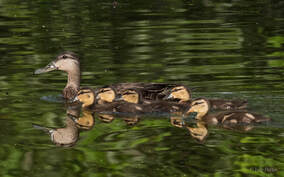
Feeding Behavior
Feeds in water by dabbling, up-ending, rarely by diving; feeds on land by grazing, plucking seeds, grubbing for roots.
Eggs
Seven to 11, sometimes 6-12, rarely 4-17. Creamy white to greenish buff. Incubation by female only, 23-33 days, typically 26-29.
Young
All eggs typically hatch in space of a few hours. Female leads young to water, often after dark. Ducklings find their own food. Young fledge at age of about 2 months, and are abandoned by female about that time.
Feeds in water by dabbling, up-ending, rarely by diving; feeds on land by grazing, plucking seeds, grubbing for roots.
Eggs
Seven to 11, sometimes 6-12, rarely 4-17. Creamy white to greenish buff. Incubation by female only, 23-33 days, typically 26-29.
Young
All eggs typically hatch in space of a few hours. Female leads young to water, often after dark. Ducklings find their own food. Young fledge at age of about 2 months, and are abandoned by female about that time.

Diet
Ducks are omnivorous. Diet varies with location and season. On fresh water, feeds mainly on plant material, including seeds, leaves, roots, berries. Seeds of various grasses, pondweeds, sedges, and others often a major part of diet. In tidal zones may feed mainly on mussels, clams, snails, small crustaceans, aquatic arthropods. Young ducklings eat many insects.
Nesting
Older birds may form pairs by early fall and remain together until following summer. Nest site variable; usually near water, as on banks or small islands, but can be up to a mile distant. Generally on ground among clumps of dense vegetation, sometimes in raised situation as on top of stump, in large tree cavity, on duck blind in water. Typical ground nest (built by female) is a shallow depression with plant material added, lined with down.
Ducks are omnivorous. Diet varies with location and season. On fresh water, feeds mainly on plant material, including seeds, leaves, roots, berries. Seeds of various grasses, pondweeds, sedges, and others often a major part of diet. In tidal zones may feed mainly on mussels, clams, snails, small crustaceans, aquatic arthropods. Young ducklings eat many insects.
Nesting
Older birds may form pairs by early fall and remain together until following summer. Nest site variable; usually near water, as on banks or small islands, but can be up to a mile distant. Generally on ground among clumps of dense vegetation, sometimes in raised situation as on top of stump, in large tree cavity, on duck blind in water. Typical ground nest (built by female) is a shallow depression with plant material added, lined with down.
The Trumpeter Swan

The trumpeter swan is the largest extant species of waterfowl. Adults usually measure 4 feet 6 inches–5 feet 5 in long, though large males can exceed 5 feet 11 inches in total length. The weight of adult birds is typically 15–30 lbs.
The trumpeter swan's wingspan ranges from 6 feet 1 inch to 8 feet 2 inches, with the wing chord measuring 60–24–27 inches. The adult trumpeter swan is all white in plumage. The cygnets of the trumpeter swan have light grey plumage and pinkish legs, gaining their white plumage after about a year. This species has upright posture and generally swims with a straight neck. The trumpeter swan has a large, wedge-shaped black bill that can, in some cases, be minimally lined with salmon-pink coloration around the mouth.
The bill, measuring 4.1–4.7 inches, is up to twice the length of a Canada goose's bill and is the largest of any waterfowl. The legs are gray-pink in color. Trumpeters are usually only found in pristine wetlands with minimal human disturbance, especially while breeding. Trumpeter swans are loud and somewhat musical creatures, with their cry sounding similar to a trumpet, which gave the bird its name.
The trumpeter swan's wingspan ranges from 6 feet 1 inch to 8 feet 2 inches, with the wing chord measuring 60–24–27 inches. The adult trumpeter swan is all white in plumage. The cygnets of the trumpeter swan have light grey plumage and pinkish legs, gaining their white plumage after about a year. This species has upright posture and generally swims with a straight neck. The trumpeter swan has a large, wedge-shaped black bill that can, in some cases, be minimally lined with salmon-pink coloration around the mouth.
The bill, measuring 4.1–4.7 inches, is up to twice the length of a Canada goose's bill and is the largest of any waterfowl. The legs are gray-pink in color. Trumpeters are usually only found in pristine wetlands with minimal human disturbance, especially while breeding. Trumpeter swans are loud and somewhat musical creatures, with their cry sounding similar to a trumpet, which gave the bird its name.

Range and habitat
Trumpeter swan abundance and productivity throughout the entire breeding ranges in three recognized North American populations: the Pacific Coast (PCP), Rocky Mountain (RMP), and Interior (IP) populations. From 1968 to 2010 the population has increased from 3,722 to approximately 46,225 birds, in large part due to re-introductions to its historic range.
Their breeding habitat is large shallow ponds, undisturbed lakes, pristine wetlands and wide slow rivers, and marshes in northwestern and central North America, with the largest numbers of breeding pairs found in Alaska. They prefer nesting sites with enough space for them to have enough surface water for them to take off, as well as accessible food, shallow, unpolluted water, and little or no human disturbance. Natural populations of these swans migrate to and from the Pacific coast and portions of the United States, flying in V-shaped flocks. Released populations are mostly non-migratory.
In the winter, they migrate to the southern tier of Canada, the eastern part of the northwest states in the United States, especially to the Red Rock Lakes area of Montana, the north Puget Sound region of northwest Washington state, they have even been observed as far south as Pagosa Springs, Colorado.
Trumpeter swan abundance and productivity throughout the entire breeding ranges in three recognized North American populations: the Pacific Coast (PCP), Rocky Mountain (RMP), and Interior (IP) populations. From 1968 to 2010 the population has increased from 3,722 to approximately 46,225 birds, in large part due to re-introductions to its historic range.
Their breeding habitat is large shallow ponds, undisturbed lakes, pristine wetlands and wide slow rivers, and marshes in northwestern and central North America, with the largest numbers of breeding pairs found in Alaska. They prefer nesting sites with enough space for them to have enough surface water for them to take off, as well as accessible food, shallow, unpolluted water, and little or no human disturbance. Natural populations of these swans migrate to and from the Pacific coast and portions of the United States, flying in V-shaped flocks. Released populations are mostly non-migratory.
In the winter, they migrate to the southern tier of Canada, the eastern part of the northwest states in the United States, especially to the Red Rock Lakes area of Montana, the north Puget Sound region of northwest Washington state, they have even been observed as far south as Pagosa Springs, Colorado.
Breeding
Like other swans, trumpeter swans often mate for life, and both parents participate in raising their young, but primarily the female incubates the eggs. Most pair bonds are formed when swans are 5 to 7 years old, although some pairs do not form until they are nearly 20 years old. "Divorces" have been known between birds, in which case the mates will be serially monogamous, with mates in differing breeding seasons. Occasionally, if his mate dies, a male trumpeter swan may not pair again for the rest of his life.
Most egg laying occurs between late April and May. The female lays 3–12 eggs, with 4 to 6 being average, in a mound of plant material on a small island, a beaver or muskrat lodge, or a floating platform on a clump of emergent vegetation. The same location may be used for several years and both members of the pair help build the nest. The nest consists of a large, open bowl of grasses, sedges and various aquatic vegetation and have ranged in diameter from 3.9 to 11.8 feet, the latter after repeated uses. The eggs average 2.9 in wide, 4.5 in long, and weigh about 11 oz. The eggs are quite possibly the largest of any flying bird alive today. The incubation period is 32 to 37 days, handled mainly by the female, although occasionally by the male as well. The young are able to swim within two days and usually are capable of feeding themselves after, at most, two weeks. The fledging stage is reached at roughly 3 to 4 months. While nesting, trumpeter swans are territorial and harass other animals, including conspecifics, who enter the area of their nest.
Adults go through a summer moult when they temporarily lose their flight feathers. The females become flightless shortly after the young hatch; the males go through this process about a month later when the females have completed their moult.
Like other swans, trumpeter swans often mate for life, and both parents participate in raising their young, but primarily the female incubates the eggs. Most pair bonds are formed when swans are 5 to 7 years old, although some pairs do not form until they are nearly 20 years old. "Divorces" have been known between birds, in which case the mates will be serially monogamous, with mates in differing breeding seasons. Occasionally, if his mate dies, a male trumpeter swan may not pair again for the rest of his life.
Most egg laying occurs between late April and May. The female lays 3–12 eggs, with 4 to 6 being average, in a mound of plant material on a small island, a beaver or muskrat lodge, or a floating platform on a clump of emergent vegetation. The same location may be used for several years and both members of the pair help build the nest. The nest consists of a large, open bowl of grasses, sedges and various aquatic vegetation and have ranged in diameter from 3.9 to 11.8 feet, the latter after repeated uses. The eggs average 2.9 in wide, 4.5 in long, and weigh about 11 oz. The eggs are quite possibly the largest of any flying bird alive today. The incubation period is 32 to 37 days, handled mainly by the female, although occasionally by the male as well. The young are able to swim within two days and usually are capable of feeding themselves after, at most, two weeks. The fledging stage is reached at roughly 3 to 4 months. While nesting, trumpeter swans are territorial and harass other animals, including conspecifics, who enter the area of their nest.
Adults go through a summer moult when they temporarily lose their flight feathers. The females become flightless shortly after the young hatch; the males go through this process about a month later when the females have completed their moult.
Diet
These birds feed while swimming, sometimes up-ending or dabbling to reach submerged food. The diet is almost entirely aquatic plants. They will eat both the leaves and stems of submerged and emergent vegetation. They will also dig into muddy substrate underwater to extract roots and tubers. In winter, they may also eat grasses and grains in fields. They will often feed at night as well as by day. Feeding activity, and the birds' weights, often peaks in the spring as they prepare for the breeding season. The young initially include insects, small fish, fish eggs and small crustaceans in their diet, providing additional protein, and change to a vegetation-based diet over the first few months.
Mortality
In captivity, members of this species have survived to 33 years old and, in the wild, have lived to at least 24 years. Young trumpeter swans may have as little as 40% chance of survival due variously to disturbance and destruction by humans, predation, nest flooding, and starvation. In some areas, though, the breeding success rate is considerably greater and, occasionally, all cygnets may reach maturity. Mortality in adults is quite low, with the survival rate usually being 80–100% annually, unless hunted by humans. Predators of trumpeter swan eggs include common raven (Corvus corax), common raccoon (Procyon lotor), wolverine (Gulo gulo), American black bear (Ursus americanus), brown bear (Ursus arctos), coyote (Canis latrans), wolves (Canis lupus), mountain lions (Puma concolor), and northern river otter (Lontra canadensis).
These birds feed while swimming, sometimes up-ending or dabbling to reach submerged food. The diet is almost entirely aquatic plants. They will eat both the leaves and stems of submerged and emergent vegetation. They will also dig into muddy substrate underwater to extract roots and tubers. In winter, they may also eat grasses and grains in fields. They will often feed at night as well as by day. Feeding activity, and the birds' weights, often peaks in the spring as they prepare for the breeding season. The young initially include insects, small fish, fish eggs and small crustaceans in their diet, providing additional protein, and change to a vegetation-based diet over the first few months.
Mortality
In captivity, members of this species have survived to 33 years old and, in the wild, have lived to at least 24 years. Young trumpeter swans may have as little as 40% chance of survival due variously to disturbance and destruction by humans, predation, nest flooding, and starvation. In some areas, though, the breeding success rate is considerably greater and, occasionally, all cygnets may reach maturity. Mortality in adults is quite low, with the survival rate usually being 80–100% annually, unless hunted by humans. Predators of trumpeter swan eggs include common raven (Corvus corax), common raccoon (Procyon lotor), wolverine (Gulo gulo), American black bear (Ursus americanus), brown bear (Ursus arctos), coyote (Canis latrans), wolves (Canis lupus), mountain lions (Puma concolor), and northern river otter (Lontra canadensis).
The Common Redpoll
|
One of the "winter finches," nesting in the Arctic and sometimes invading southern Canada and the northern states. Redpolls are tiny, restless birds, feeding actively on seeds among trees and weeds, fluttering and climbing about acrobatically, their flocks seemingly always on the move.
For their small size, they have a remarkable ability to survive cold temperatures; their southward flights are sparked by temporary scarcity of food in the North, not by cold. At bird feeders in winter, redpolls are often remarkably tame. |

Feeding Behavior
Forages very actively in trees, shrubs, weeds, and on the ground. Except when nesting, usually forages in flocks. Has a pouch within throat where it can store some food for up to several hours; this helps the bird in bitterly cold weather, allowing it to feed rapidly in the open and then digest food over a long period while it rests in a sheltered spot.
Eggs
Four to Five, rarely up to 7. Pale green to blue-green, with purplish to reddish brown spots often concentrated at larger end. Incubation is by female only, about 10-11 days. Male feeds female during incubation. Young: Fed mostly by female; contribution by male varies. Young leave the nest about 12 days after hatching.
Diet
Mostly seeds, some insects. Diet for most of year is mostly seeds and other vegetable matter. Feeds on catkins, seeds, and buds of willows, alders, and birches, small conifer seeds, also seeds of many weeds and grasses. Also eats insects, mainly in summer.
Nesting
Males dominate females in winter flocks, but as breeding season approaches, females become dominant and may take the lead in courtship. Does not seem to defend much of a nesting territory; nests of different pairs may be close together. The nest is usually very well hidden in dense low shrubs, within a few feet of the ground, sometimes in grass clumps or under brushpiles. Nest (probably built by female) consists of fine twigs, grass, moss, lined with feathers (especially ptarmigan feathers), plant down, or animal hair.
Forages very actively in trees, shrubs, weeds, and on the ground. Except when nesting, usually forages in flocks. Has a pouch within throat where it can store some food for up to several hours; this helps the bird in bitterly cold weather, allowing it to feed rapidly in the open and then digest food over a long period while it rests in a sheltered spot.
Eggs
Four to Five, rarely up to 7. Pale green to blue-green, with purplish to reddish brown spots often concentrated at larger end. Incubation is by female only, about 10-11 days. Male feeds female during incubation. Young: Fed mostly by female; contribution by male varies. Young leave the nest about 12 days after hatching.
Diet
Mostly seeds, some insects. Diet for most of year is mostly seeds and other vegetable matter. Feeds on catkins, seeds, and buds of willows, alders, and birches, small conifer seeds, also seeds of many weeds and grasses. Also eats insects, mainly in summer.
Nesting
Males dominate females in winter flocks, but as breeding season approaches, females become dominant and may take the lead in courtship. Does not seem to defend much of a nesting territory; nests of different pairs may be close together. The nest is usually very well hidden in dense low shrubs, within a few feet of the ground, sometimes in grass clumps or under brushpiles. Nest (probably built by female) consists of fine twigs, grass, moss, lined with feathers (especially ptarmigan feathers), plant down, or animal hair.
The Tree Swallow
|
The popularity of the bluebird has been a boon to the Tree Swallow, which nests in holes of exactly the same size, and has taken advantage of bluebird houses over much of North America. In regions with no such ready supply of artificial nest sites, the swallows must compete with other cavity-nesting birds, arriving early in spring to stake out territories. Unlike other swallows, Tree Swallows eat many berries (especially bayberries), allowing them to survive through wintry spells when other insect-eaters might starve.
|
|
Habitat:
Open country near water, marshes, meadows, lakes. May breed in any kind of open or semi-open area that provides both nesting sites and a good supply of flying insects. Typically breeds close to water, as around ponds or marshes, but also nests away from water around meadows or brushy areas. In winter, mainly around marshes and near bayberry thickets along coast. Feeding Behavior Forages mostly in flight, often low over water or fields. May pick items from surface of water while flying. Perches in bushes to eat berries, and sometimes feeds on ground, especially in cold weather. |
Eggs
4-7, sometimes 2-8. Very pale pink at first, fading to white. Incubation is by female only, usually 14-15 days. Young: Both parents feed nestlings, and female broods them while they are small. Young usually leave the nest about 18-22 days after hatching. Both parents feed nestlings
Diet
Mostly insects, some berries. Diet is mostly insects, especially in summer. Feeds on many flies, beetles, winged ants, and others. Also eats some spiders, and will eat sand fleas (which are crustaceans). Unlike our other swallows, eats much vegetable material (up to 20% of annual diet, mostly eaten in winter). Bayberries are main plant food, also eats other berries and seeds.
Nesting
Male arrives on nesting territory before female; courtship involves male showing female potential nesting sites. Birds often choose new mates each year. Nest: Natural nest sites are in holes in dead trees, or in old sapsucker holes in live trees; also very frequently uses nest boxes. Sometimes in odd sites such as holes in buildings, old Cliff Swallow nests, or holes in ground. Nest (built mostly by female) is cup of grass, weeds, rootlets, moss, pine needles, other plant materials. Usually lined with many feathers (from other kinds of birds), mostly added after first eggs are laid.
4-7, sometimes 2-8. Very pale pink at first, fading to white. Incubation is by female only, usually 14-15 days. Young: Both parents feed nestlings, and female broods them while they are small. Young usually leave the nest about 18-22 days after hatching. Both parents feed nestlings
Diet
Mostly insects, some berries. Diet is mostly insects, especially in summer. Feeds on many flies, beetles, winged ants, and others. Also eats some spiders, and will eat sand fleas (which are crustaceans). Unlike our other swallows, eats much vegetable material (up to 20% of annual diet, mostly eaten in winter). Bayberries are main plant food, also eats other berries and seeds.
Nesting
Male arrives on nesting territory before female; courtship involves male showing female potential nesting sites. Birds often choose new mates each year. Nest: Natural nest sites are in holes in dead trees, or in old sapsucker holes in live trees; also very frequently uses nest boxes. Sometimes in odd sites such as holes in buildings, old Cliff Swallow nests, or holes in ground. Nest (built mostly by female) is cup of grass, weeds, rootlets, moss, pine needles, other plant materials. Usually lined with many feathers (from other kinds of birds), mostly added after first eggs are laid.
The Barn Swallow
The barn swallow is a bird of open country that normally uses man-made structures to breed and consequently has spread with human expansion. It builds a cup nest from mud pellets in barns or similar structures and feeds on insects caught in flight. This species lives in close association with humans, and its insect-eating habits mean that it is tolerated by humans.
The preferred habitat of the barn swallow is open country with low vegetation, such as pasture, meadows and farmland, preferably with nearby water. This swallow avoids heavily wooded or precipitous areas and densely built-up locations. The presence of accessible open structures such as barns, stables, or culverts to provide nesting sites, and exposed locations such as wires, roof ridges or bare branches for perching, are also important in the bird's selection of its breeding range.
The preferred habitat of the barn swallow is open country with low vegetation, such as pasture, meadows and farmland, preferably with nearby water. This swallow avoids heavily wooded or precipitous areas and densely built-up locations. The presence of accessible open structures such as barns, stables, or culverts to provide nesting sites, and exposed locations such as wires, roof ridges or bare branches for perching, are also important in the bird's selection of its breeding range.
|
The barn swallow is similar in its habits to other aerial insectivores, including other swallow species and the unrelated swifts. It is not a particularly fast flier, with a wing beat rate of approximately 5, up to 7–9 times each second.
The barn swallow typically feeds in open areas (23–26 ft) above shallow water or the ground often following animals, humans or farm machinery to catch disturbed insects, but it will occasionally pick prey items from the water surface, walls and plants. In the breeding areas, large flies make up around 70% of the diet, with aphids also a significant component. |
The breeding season of the barn swallow is variable; in the southern part of the range, the breeding season usually is from February or March to early to mid September, although some late second and third broods finish in October. In the northern part of the range, it usually starts late May to early June and ends the same time as the breeding season of the southernmost birds. Both sexes defend the nest, but the male is particularly aggressive and territorial. Once established, pairs stay together to breed for life.
As its name implies, the barn swallow typically nests inside accessible buildings such as barns and stables, or under bridges and wharves. Before man-made sites became common, it nested on cliff faces or in caves, but this is now rare. The neat cup-shaped nest is placed on a beam or against a suitable vertical projection. It is constructed by both sexes, although more often by the female, with mud pellets collected in their beaks and lined with grasses, feathers, algae or other soft materials. After building the nest, barn swallows may nest colonially where sufficient high-quality nest sites are available.
In North America at least, barn swallows frequently engage in a mutualist relationship with ospreys. Barn swallows will build their nest below an osprey nest, receiving protection from other birds of prey that are repelled by the exclusively fish-eating ospreys. The ospreys are alerted to the presence of these predators by the alarm calls of the swallows.
There are normally two broods, with the original nest being reused for the second brood and being repaired and reused in subsequent years. The female lays two to seven, but typically four or five, reddish-spotted white eggs. The incubation period is normally 14–19 days, with another 18–23 days before the altricial chicks fledge. The fledged young stay with, and are fed by, the parents for about a week after leaving the nest. Occasionally, first-year birds from the first brood will assist in feeding the second brood. Compared to those from early broods, juvenile barn swallows from late broods have been found to migrate at a younger age, fuel less efficiently during migration and have lower return rates the following year.
As its name implies, the barn swallow typically nests inside accessible buildings such as barns and stables, or under bridges and wharves. Before man-made sites became common, it nested on cliff faces or in caves, but this is now rare. The neat cup-shaped nest is placed on a beam or against a suitable vertical projection. It is constructed by both sexes, although more often by the female, with mud pellets collected in their beaks and lined with grasses, feathers, algae or other soft materials. After building the nest, barn swallows may nest colonially where sufficient high-quality nest sites are available.
In North America at least, barn swallows frequently engage in a mutualist relationship with ospreys. Barn swallows will build their nest below an osprey nest, receiving protection from other birds of prey that are repelled by the exclusively fish-eating ospreys. The ospreys are alerted to the presence of these predators by the alarm calls of the swallows.
There are normally two broods, with the original nest being reused for the second brood and being repaired and reused in subsequent years. The female lays two to seven, but typically four or five, reddish-spotted white eggs. The incubation period is normally 14–19 days, with another 18–23 days before the altricial chicks fledge. The fledged young stay with, and are fed by, the parents for about a week after leaving the nest. Occasionally, first-year birds from the first brood will assist in feeding the second brood. Compared to those from early broods, juvenile barn swallows from late broods have been found to migrate at a younger age, fuel less efficiently during migration and have lower return rates the following year.
The Canada Goose
This big "Honker" is among our best-known waterfowl. In many regions, flights of Canada Geese passing over in V-formation -- northbound in spring, southbound in fall -- are universally recognized as signs of the changing seasons. Once considered a symbol of wilderness, this goose has adapted well to civilization, nesting around park ponds and golf courses; in a few places, it has even become something of a nuisance. Local forms vary greatly in size, and the smallest ones are now regarded as a separate species, Cackling Goose.
Feeding Behavior
Canada Geese forage mostly by grazing while walking on land; they also feed in water, submerging their head and neck, sometimes up-ending. It feeds in flocks at most seasons.
Eggs
Usually 4-7, sometimes 2-11. White, becoming nest-stained. Incubation is by female, 25-28 days; male stands guard nearby. Young: Parents lead young from nest 1-2 days after hatching.
Young
Parents lead young from nest 1-2 days after hatching. Young are tended by both parents, but feed themselves. Age at first flight varies, usually 7-9 weeks, tending to be longer in the largest forms.
Diet
These geese feed almost entirely on plant material. They feeds on very wide variety of plants, eating stems and shoots of grasses, sedges, aquatic plants, also seeds and berries. They consume many cultivated grains (especially on refuges, where crops planted are for geese). Occasionally they will eat some insects, mollusks, crustaceans, and sometimes small fish.
Nesting
May mate for life. Male defends territory with displays, including lowering head almost to ground with bill slightly raised and open, hissing; also pumps head up and down while standing. Nest site (chosen by female) is usually on slightly elevated dry ground near water, with good visibility. Much variation; may nest on cliff ledges, on muskrat houses, in trees, on artificial platforms. Nest (built by female) is slight depression with shallow bowl of sticks, grass, weeds, moss, lined with down.
Source: National Audubon Society
Feeding Behavior
Canada Geese forage mostly by grazing while walking on land; they also feed in water, submerging their head and neck, sometimes up-ending. It feeds in flocks at most seasons.
Eggs
Usually 4-7, sometimes 2-11. White, becoming nest-stained. Incubation is by female, 25-28 days; male stands guard nearby. Young: Parents lead young from nest 1-2 days after hatching.
Young
Parents lead young from nest 1-2 days after hatching. Young are tended by both parents, but feed themselves. Age at first flight varies, usually 7-9 weeks, tending to be longer in the largest forms.
Diet
These geese feed almost entirely on plant material. They feeds on very wide variety of plants, eating stems and shoots of grasses, sedges, aquatic plants, also seeds and berries. They consume many cultivated grains (especially on refuges, where crops planted are for geese). Occasionally they will eat some insects, mollusks, crustaceans, and sometimes small fish.
Nesting
May mate for life. Male defends territory with displays, including lowering head almost to ground with bill slightly raised and open, hissing; also pumps head up and down while standing. Nest site (chosen by female) is usually on slightly elevated dry ground near water, with good visibility. Much variation; may nest on cliff ledges, on muskrat houses, in trees, on artificial platforms. Nest (built by female) is slight depression with shallow bowl of sticks, grass, weeds, moss, lined with down.
Source: National Audubon Society
Ondatra zibethicus
Muskrats are unique, semi-aquatic rodents named for their musky smell and rat-like appearance. They're known mostly for their destructive burrowing in ponds, streams and dams, but there's more than this to these large wetland-dwelling mammals. The muskrat and its bigger cousin, the beaver, are the only mammals that actually build homes in the water. That is where they spend the winter and raise their young.
Identification
General description: The muskrat swims low in the water, with its long, almost-hairless tail curling behind. Often, the muskrat can be seen carrying aquatic vegetation as it swims.
Length: The muskrat is about 20 inches long, including its 9-inch tail.
Weight: Adults weigh from 2 to 5 pounds.
Color: The upper body is reddish brown, while the under parts are grayish
brown.
Reproduction
Muskrats produce many young. An adult female can have two or three litters of up to 10 young each summer. The young weigh about one-half ounce at birth, but grow rapidly and can live on their own after only one month.
Food
Muskrats eat the roots, stems, leaves, and fruits of a many water plants, such as cattail, wild rice, water lilies, and rushes. Even though the muskrat is mainly a plant eater, it also eats small fish, clams, snails, and even turtles.
Predators
The muskrat's main predators are mink and otters. Some raptors (bird predators) such as eagles and ospreys will attack swimming muskrats. When on land, muskrats are vulnerable to predation by foxes, coyotes and raccoons.
Habitat and range
The muskrat is native to North America and is an introduced species in parts of Europe, Asia, and South America. The muskrat is found in wetlands over a wide range of climates and habitats. It lives in marshes, ponds, and streams that have many water plants. Several hundred muskrats can live in a single wetland. Although famous for its domed houses of mud and vegetation, it just as often lives in burrows.
Population and management
A valuable furbearer, the muskrat provides income for trappers of all ages. Trapping, of course, helps to keep these prolific animals in balance with their habitat. Muskrats have several litters each season. If they become overly-abundant, they may create problems by digging holes in dikes and dams or tunneling out bank dens along lake and river shorelands.
Fun facts
Unlike the beaver, the muskrat does not store food for the winter. It needs to eat fresh plants each day, and sometimes it makes channels in the mud to get from its house to reach food under the ice. To stay warm in winter, groups of muskrats huddle together in their lodges.
Muskrats are unique, semi-aquatic rodents named for their musky smell and rat-like appearance. They're known mostly for their destructive burrowing in ponds, streams and dams, but there's more than this to these large wetland-dwelling mammals. The muskrat and its bigger cousin, the beaver, are the only mammals that actually build homes in the water. That is where they spend the winter and raise their young.
Identification
General description: The muskrat swims low in the water, with its long, almost-hairless tail curling behind. Often, the muskrat can be seen carrying aquatic vegetation as it swims.
Length: The muskrat is about 20 inches long, including its 9-inch tail.
Weight: Adults weigh from 2 to 5 pounds.
Color: The upper body is reddish brown, while the under parts are grayish
brown.
Reproduction
Muskrats produce many young. An adult female can have two or three litters of up to 10 young each summer. The young weigh about one-half ounce at birth, but grow rapidly and can live on their own after only one month.
Food
Muskrats eat the roots, stems, leaves, and fruits of a many water plants, such as cattail, wild rice, water lilies, and rushes. Even though the muskrat is mainly a plant eater, it also eats small fish, clams, snails, and even turtles.
Predators
The muskrat's main predators are mink and otters. Some raptors (bird predators) such as eagles and ospreys will attack swimming muskrats. When on land, muskrats are vulnerable to predation by foxes, coyotes and raccoons.
Habitat and range
The muskrat is native to North America and is an introduced species in parts of Europe, Asia, and South America. The muskrat is found in wetlands over a wide range of climates and habitats. It lives in marshes, ponds, and streams that have many water plants. Several hundred muskrats can live in a single wetland. Although famous for its domed houses of mud and vegetation, it just as often lives in burrows.
Population and management
A valuable furbearer, the muskrat provides income for trappers of all ages. Trapping, of course, helps to keep these prolific animals in balance with their habitat. Muskrats have several litters each season. If they become overly-abundant, they may create problems by digging holes in dikes and dams or tunneling out bank dens along lake and river shorelands.
Fun facts
Unlike the beaver, the muskrat does not store food for the winter. It needs to eat fresh plants each day, and sometimes it makes channels in the mud to get from its house to reach food under the ice. To stay warm in winter, groups of muskrats huddle together in their lodges.
Fun Facts About Fishers
Compiled by Jaydin Hopkins, Lakeland Union High School Student
Images: Courtesy of Google Images
Source: http://www.softschools.com/facts/animals/fisher_facts/1235/
Images: Courtesy of Google Images
Source: http://www.softschools.com/facts/animals/fisher_facts/1235/
- Fishers can reach 30 to 40 inches in length and weigh 4 to 14 pounds. Males are much larger than females. (basically a large weasel)
- Fishers are covered with dark brown, nearly black fur. Head and shoulders are covered with light-colored fur with white tips that create a grizzled appearance.
- Females have softer fur than males.
- Fur is glossy and dense during the winter and light-colored and less dense during the summer.
- A fisher has a slender body, short legs and a long, bushy tail. Large paws are equipped with sharp, retractable claws (they can be hidden inside the paws) which facilitate climbing trees.
- Fishers are mainly active during the night (nocturnal) and twilight (crepuscular)
- Fishers mainly feed on meat (carnivores). Their diet is based on snowshoe hares, rabbits, mice, squirrels, shrews, porcupines, and birds. Fishers hunt their prey using the element of surprise although they occasionally eats berries, fruit, mushroom and beechnuts.
- Despite its name, fishers rarely eats fish.
- Fishers rest in the crevices of rocks and abandoned nests of squirrels and birds (tree cavities) during the day.
- They are solitary and territorial animals, and occupy a territory of 3 to 8 square miles (depending on available food sources.)
- A fisher produces hissing and growling sounds when it is threatened. Humans are the main predators of fishers.
- Fishers use a substance from the gland in their hind paws to mark their trails during the breeding season (males and females can find each other thanks to this substance).
- Mating season of the fisher takes place during April.
- Females are able to delay pregnancy. Fertilized eggs will start to develop 9 to 10 months after copulation. Embryonic development lasts 50 days.
- Females give birth to 1 to 4 (usually 3) babies (called kits) in the dens in cavities of trees. Babies are blind and nearly naked at birth. Only the mother takes care of the babies.
- Kits depend on their mother's milk during the first 8 to 10 weeks of their life. After that, they start to eat solid food.
- Young fishers become independent at the age of 5 months and reach sexual maturity at the age of one year.
- A fisher can survive 10 years in the wild.
What you Didn't Know About Chipmunks. . . .
Compiled by Jaydin Hopkins, Lakeland Union High School Student
Images: Courtesy of Google Images
Images: Courtesy of Google Images
CHIPMUNKS HIBERNATE - BUT NOT CONTINOUSLY
Starting in late October, they fall into a deep sleep with a slowed heart rate and lower body temperature for extended periods until March or April. Unlike bears, though, chipmunks don’t bulk up their fat stores to sleep through the entire cold season. Instead they wake periodically to dip into their stockpile of nuts and seeds and even venture outside.
THEY NEED ABOUT 15 HOURS OF SLEEP A DAY
At least that’s true of chipmunks in captivity. If their wild cousins require the same amount of snooze time, then all that zippy scampering you see outside has to get done during a nine-hour window each day, says Wildlife Animal Control.
THEY ARE BORN LONERS
Despite their reputation for cuddly camaraderie in cartoons, real chipmunks don’t bear much resemblance to their big-screen counterparts. In fact, they’re mostly solitary creatures — at least until breeding season arrives. Twice a year in spring and late summer, males (called bucks) and females (does) come together to mate, then part ways again. Female chipmunks raise the pups, but don’t remain close to their offspring once they leave.
Starting in late October, they fall into a deep sleep with a slowed heart rate and lower body temperature for extended periods until March or April. Unlike bears, though, chipmunks don’t bulk up their fat stores to sleep through the entire cold season. Instead they wake periodically to dip into their stockpile of nuts and seeds and even venture outside.
THEY NEED ABOUT 15 HOURS OF SLEEP A DAY
At least that’s true of chipmunks in captivity. If their wild cousins require the same amount of snooze time, then all that zippy scampering you see outside has to get done during a nine-hour window each day, says Wildlife Animal Control.
THEY ARE BORN LONERS
Despite their reputation for cuddly camaraderie in cartoons, real chipmunks don’t bear much resemblance to their big-screen counterparts. In fact, they’re mostly solitary creatures — at least until breeding season arrives. Twice a year in spring and late summer, males (called bucks) and females (does) come together to mate, then part ways again. Female chipmunks raise the pups, but don’t remain close to their offspring once they leave.
THEY ARE NOT ADORABLE AT BIRTH
Baby chipmunks (called kits, kittens or pups) are born blind, hairless and helpless. Imagine something that looks like a pink jelly bean. Pups develop quickly, though, and leave the nest by 4 to 6 weeks of age to make their own way in the world.
THEY'RE KIN TO SQUIRRELS
Weighing in at 1 to 5 ounces, chipmunks are the most diminutive members of the squirrel family, according to the National Wildlife Federation. That means these pocket-sized rodents are also related to woodchucks and prairie dogs, which share a branch on the squirrel family tree as well. There are 25 species of chipmunks, ranging mostly from Canada to Mexico across a variety of stomping grounds from forests to deserts to suburban neighborhoods, according to National Geographic. Only one species, the Siberian chipmunk, makes its home outside North America, scampering over much of northern Asia as well as in Europe where it was introduced via the pet trade in the 1960s.
A SUBTERRANEAN LIFE
While some chipmunks make nests in logs or bushes, most prefer to dig vast underground burrows. These hidden homes typically include a camouflaged entrance hole, tunnel systems that can stretch 10 to 30 feet long, food storage areas and a nesting chamber (which is kept immaculately clean and lined with leaves and other plant matter).
Baby chipmunks (called kits, kittens or pups) are born blind, hairless and helpless. Imagine something that looks like a pink jelly bean. Pups develop quickly, though, and leave the nest by 4 to 6 weeks of age to make their own way in the world.
THEY'RE KIN TO SQUIRRELS
Weighing in at 1 to 5 ounces, chipmunks are the most diminutive members of the squirrel family, according to the National Wildlife Federation. That means these pocket-sized rodents are also related to woodchucks and prairie dogs, which share a branch on the squirrel family tree as well. There are 25 species of chipmunks, ranging mostly from Canada to Mexico across a variety of stomping grounds from forests to deserts to suburban neighborhoods, according to National Geographic. Only one species, the Siberian chipmunk, makes its home outside North America, scampering over much of northern Asia as well as in Europe where it was introduced via the pet trade in the 1960s.
A SUBTERRANEAN LIFE
While some chipmunks make nests in logs or bushes, most prefer to dig vast underground burrows. These hidden homes typically include a camouflaged entrance hole, tunnel systems that can stretch 10 to 30 feet long, food storage areas and a nesting chamber (which is kept immaculately clean and lined with leaves and other plant matter).
FOOD GLORIOUS FOOD!!
Chipmunks aren’t picky eaters and spend a lot of time searching for their next meal, including at bird feeders (as many annoyed homeowners can attest). These omnivores love nuts, berries, seeds, mushrooms, insects, frogs, lizards, baby birds and bird eggs. During late summer and fall, they begin carrying extra food back to their burrow in their ample cheek pouches (which can hold a stash three times the size of their head). This foraging also benefits the larger ecosystem — chipmunks spread seeds and important mycorrhizal fungi that live around tree roots, ensuring they thrive.
A BOATLOAD OF ENEMIES
Just about any carnivore bigger than one of these bitty critters is a potential threat. Think owls, hawks, weasels, foxes, coyotes, raccoons, bobcats, lynxes, cats, dogs, snakes, and sometimes even their own red squirrel cousins. Chipmunks avoid becoming meals by being quick and nimble — and sticking close to home. These super-speedy escape artists remain ever vigilant while out foraging for food, racing away at the first sign of danger down their burrow hole, into the brush or even up a tree.
Chipmunks aren’t picky eaters and spend a lot of time searching for their next meal, including at bird feeders (as many annoyed homeowners can attest). These omnivores love nuts, berries, seeds, mushrooms, insects, frogs, lizards, baby birds and bird eggs. During late summer and fall, they begin carrying extra food back to their burrow in their ample cheek pouches (which can hold a stash three times the size of their head). This foraging also benefits the larger ecosystem — chipmunks spread seeds and important mycorrhizal fungi that live around tree roots, ensuring they thrive.
A BOATLOAD OF ENEMIES
Just about any carnivore bigger than one of these bitty critters is a potential threat. Think owls, hawks, weasels, foxes, coyotes, raccoons, bobcats, lynxes, cats, dogs, snakes, and sometimes even their own red squirrel cousins. Chipmunks avoid becoming meals by being quick and nimble — and sticking close to home. These super-speedy escape artists remain ever vigilant while out foraging for food, racing away at the first sign of danger down their burrow hole, into the brush or even up a tree.
Red-breasted Nuthatch
Photos by Jody Partin, McNaughton, Wisconsin
RED-BREASTED NUTHATCH
Size & Shape
A small, compact bird with a sharp expression accentuated by its long, pointed bill. Red-breasted Nuthatches have very short tails and almost no neck; the body is plump or barrel-chested, and the short wings are very broad.
Color Pattern
Red-breasted Nuthatches are blue-gray birds with strongly patterned heads: a black cap and stripe through the eye broken up by a white stripe over the eye. The underparts are rich rusty-cinnamon, paler in females.
Behavior
Red-breasted Nuthatches move quickly over trunks and branches probing for food in crevices and under flakes of bark. They creep up, down, and sideways without regard for which way is up, and they don’t lean against their tail the way woodpeckers do. Flight is short and bouncy.
Habitat
Red-breasted Nuthatches are mainly birds of coniferous woods and mountains. Look for them among spruce, fir, pine, hemlock, larch, and western red cedar as well as around aspens and poplars. In northeastern North America you can also find them in forests of oak, hickory, maple, birch, and other deciduous trees.
Size & Shape
A small, compact bird with a sharp expression accentuated by its long, pointed bill. Red-breasted Nuthatches have very short tails and almost no neck; the body is plump or barrel-chested, and the short wings are very broad.
Color Pattern
Red-breasted Nuthatches are blue-gray birds with strongly patterned heads: a black cap and stripe through the eye broken up by a white stripe over the eye. The underparts are rich rusty-cinnamon, paler in females.
Behavior
Red-breasted Nuthatches move quickly over trunks and branches probing for food in crevices and under flakes of bark. They creep up, down, and sideways without regard for which way is up, and they don’t lean against their tail the way woodpeckers do. Flight is short and bouncy.
Habitat
Red-breasted Nuthatches are mainly birds of coniferous woods and mountains. Look for them among spruce, fir, pine, hemlock, larch, and western red cedar as well as around aspens and poplars. In northeastern North America you can also find them in forests of oak, hickory, maple, birch, and other deciduous trees.
The Snapping Turtle
COMMON SNAPPING TURTLE
Chelydra serpentina
Hatchling and juvenile snapping turtles are interesting and docile animals. They seem to acquire the adult aggressive at age 3 or 4. However, common snapping turtles grow rather quickly and a small juvenile will soon become too large for the typical household aquarium. Adults do not make good pets and can inflict a painful bite.
Juveniles can be kept in aquariums with shallow water. They are not particularly strong swimmers and should be given some structure to hide in, such as small logs or branches. They rarely bask, but will benefit from a multi-spectrum lighting system.
Common snapping turtles are actually quite omnivorous, eating aquatic plants, as well as aquatic insects, tadpoles and crayfish. Adults will scavenge dead fish, but are unlikely to capture healthy game fish, a crime they are often accused of. Juveniles will consume turtle pellets in captivity.
Chelydra serpentina
- Family: Chelydridae
- Adult Size: More than 14 inches, generally not more than 35 lbs in the wild, however captives have been known to reach 60 lbs or more. Males are generally larger than females.
- Range: The common snapping turtle’s natural range covers the entire eastern United States and southern Canada, extending from Nova Scotia and Maine in the northeast, to Florida in the south, and eastern New Mexico and eastern Montana in the west. However, common snapping turtles have been introduced outside of their natural range and have been reported from the Rio Grande in New Mexico, and are now found in many habitats in California, Oregon and Washington.
- Habitat: Common snapping turtles are habitat generalists, and are found in lakes, farm ponds, shallow wetlands, small streams and river systems. They are capable of moving overland and will do so to search for new bodies of water.
- Captive Lifespan: More than 20 Years
Hatchling and juvenile snapping turtles are interesting and docile animals. They seem to acquire the adult aggressive at age 3 or 4. However, common snapping turtles grow rather quickly and a small juvenile will soon become too large for the typical household aquarium. Adults do not make good pets and can inflict a painful bite.
Juveniles can be kept in aquariums with shallow water. They are not particularly strong swimmers and should be given some structure to hide in, such as small logs or branches. They rarely bask, but will benefit from a multi-spectrum lighting system.
Common snapping turtles are actually quite omnivorous, eating aquatic plants, as well as aquatic insects, tadpoles and crayfish. Adults will scavenge dead fish, but are unlikely to capture healthy game fish, a crime they are often accused of. Juveniles will consume turtle pellets in captivity.
The Eastern Chipmunk
Description:
A small species, it reaches about 30 cm (12 in) in length including the tail, and a weight of 66–150 g (2.3–5.3 oz). It has reddish-brown fur on its upper body and five dark brown stripes contrasting with light brown stripes along its back, ending in a dark tail. It has lighter fur on the lower part of its body. It has a tawny stripe that runs from its whiskers to below its ears, and light stripes over its eyes. It has two fewer teeth than other chipmunks and four toes each on the front legs, but five on the hind legs.
Habitat:
The eastern chipmunk lives in deciduoous wooded areas and urban parks throughout the eastern United States and southern Canada. It prefers locations with rocky areas, brush or log piles, and shrubs to provide cover.
Behavior:
It can climb trees well, but constructs underground nests with extensive tunnel systems, often with several entrances. To hide the construction of its burrow, the eastern chipmunk carries soil to a different location in its cheek pouches. It also lines the burrow with leaves, rocks, sticks, and other material, making it even harder to see. It has several bird-like or chattering calls; one is a trill at the rate of 130 vibrations per minute and another is a lower-pitched, clicking sound.
Diet:
It is mainly active during the day, spending most of its day foraging. It prefers bulbs, seeds, fruits, nuts, green plants, mushrooms, insects, worms, and bird eggs. Like other chipmunks, it transports food in pouches in its cheeks.
Lifecycle:
The eastern chipmunk defends its burrow and lives a solitary life, except during mating season. Females usually produce one or two litters of three to five young. The two breeding seasons are from February to April and from June to August. During the winter, the chipmunk may enter long periods of torpor, but does not truly hibernate. Predators of the eastern chipmunk include hawks, foxes, raccoons, weasels, snakes, bobcats, lynx, and domestic cats. On average, eastern chipmunks live three or more years in the wild, but in captivity they may live as long as eight years.
A small species, it reaches about 30 cm (12 in) in length including the tail, and a weight of 66–150 g (2.3–5.3 oz). It has reddish-brown fur on its upper body and five dark brown stripes contrasting with light brown stripes along its back, ending in a dark tail. It has lighter fur on the lower part of its body. It has a tawny stripe that runs from its whiskers to below its ears, and light stripes over its eyes. It has two fewer teeth than other chipmunks and four toes each on the front legs, but five on the hind legs.
Habitat:
The eastern chipmunk lives in deciduoous wooded areas and urban parks throughout the eastern United States and southern Canada. It prefers locations with rocky areas, brush or log piles, and shrubs to provide cover.
Behavior:
It can climb trees well, but constructs underground nests with extensive tunnel systems, often with several entrances. To hide the construction of its burrow, the eastern chipmunk carries soil to a different location in its cheek pouches. It also lines the burrow with leaves, rocks, sticks, and other material, making it even harder to see. It has several bird-like or chattering calls; one is a trill at the rate of 130 vibrations per minute and another is a lower-pitched, clicking sound.
Diet:
It is mainly active during the day, spending most of its day foraging. It prefers bulbs, seeds, fruits, nuts, green plants, mushrooms, insects, worms, and bird eggs. Like other chipmunks, it transports food in pouches in its cheeks.
Lifecycle:
The eastern chipmunk defends its burrow and lives a solitary life, except during mating season. Females usually produce one or two litters of three to five young. The two breeding seasons are from February to April and from June to August. During the winter, the chipmunk may enter long periods of torpor, but does not truly hibernate. Predators of the eastern chipmunk include hawks, foxes, raccoons, weasels, snakes, bobcats, lynx, and domestic cats. On average, eastern chipmunks live three or more years in the wild, but in captivity they may live as long as eight years.
The White-lined Sphinx Hummingbird Moth
Sphinx moths are larger than most moths and the White-Lined Sphinx Moth is no exception. Their forewings are mostly brown, but each has a thick white line that extends from the base (by the head) to the tip of the wing. Thin white lines cross this thicker one in spaced intervals from the left to the right side of each forewing. The tops of the hindwings each have a flash of bright pink that is only visible when the moth completely spreads its forewings ('top' wings) open. The White-Lined Sphinx Moth hovers over flowers, much like a bird, and can be found in a variety of habitats.
It is very hairy so it could be mistaken as a small bird if not closely observed. The species is active both day and at night. They are attracted to lights and many of them may congregate together at a light source at night. The caterpillar comes in a wide variety of colors. A more mature caterpillar is horned and can be black with yellow lines on the sides. The immature caterpillar is known to feed on a large variety of plants, but more mature ones tend to prefer evening primrose and roses. This species is known to have population explosions in drier country. Its enormous range covers most of North America.
This creature video comes to you from the backyard of Chuck and Cyndy Devereaux from Sugar Camp in Oneida County.
It is very hairy so it could be mistaken as a small bird if not closely observed. The species is active both day and at night. They are attracted to lights and many of them may congregate together at a light source at night. The caterpillar comes in a wide variety of colors. A more mature caterpillar is horned and can be black with yellow lines on the sides. The immature caterpillar is known to feed on a large variety of plants, but more mature ones tend to prefer evening primrose and roses. This species is known to have population explosions in drier country. Its enormous range covers most of North America.
This creature video comes to you from the backyard of Chuck and Cyndy Devereaux from Sugar Camp in Oneida County.
The Monarch Butterfly
These Monarch butterfly photos were taken by
AIS Project Lead, Aubrey Nycz at
the Boom Lake Boat Landing in Rhinelander on August 10, 2018.
The butterflies are enjoying the pretty Joe Pye Weed that was
planted beginning in 2015 to restore a site that had previously
been covered in the invasive Yellow iris.
AIS Project Lead, Aubrey Nycz at
the Boom Lake Boat Landing in Rhinelander on August 10, 2018.
The butterflies are enjoying the pretty Joe Pye Weed that was
planted beginning in 2015 to restore a site that had previously
been covered in the invasive Yellow iris.
DESCRIPTION
Brilliant orange-and-black monarchs are among the most easily recognizable of the butterfly species that call the Americas home. Their migration takes them as far north as Canada and, during the winter months, as far south as Mexico City. A single monarch can travel hundreds to thousands of miles.
The monarch migration is one of the greatest natural phenomena in the insect world. Monarchs are truly spectacular migrants because the butterflies know the correct direction to migrate, even though they have never made the journey before. They follow an internal "compass" that points them in the right direction each spring and fall.
Like viceroy butterflies, which mimic the appearance of the monarch, this butterfly is bright orange with black and white markings. The body of the monarch is black, and the head has a set of antennae. The wings are mostly orange with black veins running throughout. The outer edge of the wings has a thick black border. Within the black border are white spots. The white spots can range in size, and they decorate the wings. At the upper corner of the top set of wings are orange spots.
The underside of the monarch butterflies' wings can be seen when the butterfly is at rest or when it is feeding on a flower. Instead of bright orange, the underside is more drab and orange-brown. Males and females can be told apart by looking at the top of their hind wings. Males have a black spot at the center of each hind wing, while the females do not. The spot is a scent gland that helps the males attract female mates. Another less accurate way to tell males from females is that the females usually have much thicker veins than the males. Monarch butterflies have a wingspan of 3.5 to 4.8 inches (9 to 12 centimeters).
Monarch butterfly caterpillars are also easy to identify. The caterpillars have many yellow, black, and white bands. There are antenna-like tentacles at each end of the caterpillar's body.
RANGE
Monarch butterflies can be found throughout the United States. The majority of monarch butterflies live east of the Rocky Mountains. In the early spring, they are first seen in Texas and other parts of the south. As spring turns to summer, they're seen in more and more states and up into Canada.
A much smaller population of monarch butterflies lives west of the Rocky Mountains. Instead of making the long journey between Mexico and Canada, the western monarchs only travel as far south as San Diego, California. Some monarchs live in California year-round and others spend summers as far north as British Columbia, Canada. Hawaii also has monarch butterflies. Monarchs that were released or lost their way from California have found success year-round on the Hawaiian Islands.
Monarch butterflies utilize different habitat in the warm months versus the cold months. In the spring, summer, and early fall, they can be found wherever there are milkweeds. Monarchs lay their eggs on milkweeds, and they're always searching for them in fields, meadows, and parks. Many people plant milkweeds in their gardens. Monarchs cannot survive freezing temperatures, so they pass the winter in the cool, high mountains of central Mexico and woodlands in central and southern California.
DIET
Monarchs, like all butterflies, change their diet as they develop. During the caterpillar stage, they live exclusively on milkweed plants. Milkweeds are wildflowers in the genus Asclepias. Milkweeds contain glycoside toxins that are harmless to the monarch, but poisonous to its predators. Monarch caterpillars feed on all the different parts of the milkweed plant and store up the toxins in their body. The toxins remain in their system even after metamorphosis, thereby making adult monarchs poisonous as well. Adult monarchs feed on nectar from a wide range of flowers, including milkweeds.
CONSERVATION
The monarch population has declined by more than 90 percent since the 1990s. The monarch butterfly faces several risks. Climate change alters the timing of migration and rainfall patterns in their forest habitat. They're also facing forest fragmentation and habitat loss in the United States and Mexico. In addition, pesticides kill milkweed, which the monarchs rely on for survival. The U.S. Fish & Wildlife Service is currently reviewing their status.
The National Wildlife Federation's Butterfly Heroes program is working to bring awareness to the declining monarch population and connect gardeners and kids and families alike to help the monarchs and other pollinators. Creating a habitat by planting milkweed or nectar plants is one easy way to help the monarch. North America has several dozen native species of milkweed, with at least one species naturally found in any given area. Planting a local species is the best option for helping monarchs is a particular area. In addition, through the National Wildlife Federation's Mayors' Monarch Pledge, cities and municipalities are committing to creating habitat and educating citizens about how they can make a difference at home for monarchs.
Roadsides also offer habitat and respite for migrating butterflies and are a focus of a coordinated Monarch Highway effort by the National Wildlife Federation along interstate I-35, located in the central flyway of the monarch butterfly migration.
The National Wildlife Federation
U.S. Fish & Wildlife Service
_______________________________________
Brilliant orange-and-black monarchs are among the most easily recognizable of the butterfly species that call the Americas home. Their migration takes them as far north as Canada and, during the winter months, as far south as Mexico City. A single monarch can travel hundreds to thousands of miles.
The monarch migration is one of the greatest natural phenomena in the insect world. Monarchs are truly spectacular migrants because the butterflies know the correct direction to migrate, even though they have never made the journey before. They follow an internal "compass" that points them in the right direction each spring and fall.
Like viceroy butterflies, which mimic the appearance of the monarch, this butterfly is bright orange with black and white markings. The body of the monarch is black, and the head has a set of antennae. The wings are mostly orange with black veins running throughout. The outer edge of the wings has a thick black border. Within the black border are white spots. The white spots can range in size, and they decorate the wings. At the upper corner of the top set of wings are orange spots.
The underside of the monarch butterflies' wings can be seen when the butterfly is at rest or when it is feeding on a flower. Instead of bright orange, the underside is more drab and orange-brown. Males and females can be told apart by looking at the top of their hind wings. Males have a black spot at the center of each hind wing, while the females do not. The spot is a scent gland that helps the males attract female mates. Another less accurate way to tell males from females is that the females usually have much thicker veins than the males. Monarch butterflies have a wingspan of 3.5 to 4.8 inches (9 to 12 centimeters).
Monarch butterfly caterpillars are also easy to identify. The caterpillars have many yellow, black, and white bands. There are antenna-like tentacles at each end of the caterpillar's body.
RANGE
Monarch butterflies can be found throughout the United States. The majority of monarch butterflies live east of the Rocky Mountains. In the early spring, they are first seen in Texas and other parts of the south. As spring turns to summer, they're seen in more and more states and up into Canada.
A much smaller population of monarch butterflies lives west of the Rocky Mountains. Instead of making the long journey between Mexico and Canada, the western monarchs only travel as far south as San Diego, California. Some monarchs live in California year-round and others spend summers as far north as British Columbia, Canada. Hawaii also has monarch butterflies. Monarchs that were released or lost their way from California have found success year-round on the Hawaiian Islands.
Monarch butterflies utilize different habitat in the warm months versus the cold months. In the spring, summer, and early fall, they can be found wherever there are milkweeds. Monarchs lay their eggs on milkweeds, and they're always searching for them in fields, meadows, and parks. Many people plant milkweeds in their gardens. Monarchs cannot survive freezing temperatures, so they pass the winter in the cool, high mountains of central Mexico and woodlands in central and southern California.
DIET
Monarchs, like all butterflies, change their diet as they develop. During the caterpillar stage, they live exclusively on milkweed plants. Milkweeds are wildflowers in the genus Asclepias. Milkweeds contain glycoside toxins that are harmless to the monarch, but poisonous to its predators. Monarch caterpillars feed on all the different parts of the milkweed plant and store up the toxins in their body. The toxins remain in their system even after metamorphosis, thereby making adult monarchs poisonous as well. Adult monarchs feed on nectar from a wide range of flowers, including milkweeds.
CONSERVATION
The monarch population has declined by more than 90 percent since the 1990s. The monarch butterfly faces several risks. Climate change alters the timing of migration and rainfall patterns in their forest habitat. They're also facing forest fragmentation and habitat loss in the United States and Mexico. In addition, pesticides kill milkweed, which the monarchs rely on for survival. The U.S. Fish & Wildlife Service is currently reviewing their status.
The National Wildlife Federation's Butterfly Heroes program is working to bring awareness to the declining monarch population and connect gardeners and kids and families alike to help the monarchs and other pollinators. Creating a habitat by planting milkweed or nectar plants is one easy way to help the monarch. North America has several dozen native species of milkweed, with at least one species naturally found in any given area. Planting a local species is the best option for helping monarchs is a particular area. In addition, through the National Wildlife Federation's Mayors' Monarch Pledge, cities and municipalities are committing to creating habitat and educating citizens about how they can make a difference at home for monarchs.
Roadsides also offer habitat and respite for migrating butterflies and are a focus of a coordinated Monarch Highway effort by the National Wildlife Federation along interstate I-35, located in the central flyway of the monarch butterfly migration.
The National Wildlife Federation
U.S. Fish & Wildlife Service
_______________________________________
The Grapeleaf Skeletonizer
The grapeleaf skeletonizer is a moth in the family Zygaenidae. It is widespread in the eastern half of the United States, and commonly noticed defoliating grapes, especially of the Virginia creeper. The western grapeleaf skeletonizer is very similar to and slightly larger than H. americana, but their distributions are different.
Larvae are yellowish and have black spots or bands. They are slightly more than 1/2 inch long when mature.
Adult moths are uniformly black except for a yellowish or orange collar. The antennae are pectinate in both sexes and plumose in the male. The forewings are four times as long as wide and more than twice the area of the hind wings. The abdomen is usually curled upwards and expanded at the tip into a fan-shaped, somewhat bilobed caudal tuft. Length of the moth is 8 to 12 mm, while the wing expanse is 22 to 28 mm.
The average length of the life cycle as 66.7 days and minimum life cycle is 53 days. Average length of the egg stage is nearly eight days, larval stage-40 days, pupal stage-15 days, and length of life of the adult moth as 3.5 days.
Larvae are yellowish and have black spots or bands. They are slightly more than 1/2 inch long when mature.
Adult moths are uniformly black except for a yellowish or orange collar. The antennae are pectinate in both sexes and plumose in the male. The forewings are four times as long as wide and more than twice the area of the hind wings. The abdomen is usually curled upwards and expanded at the tip into a fan-shaped, somewhat bilobed caudal tuft. Length of the moth is 8 to 12 mm, while the wing expanse is 22 to 28 mm.
The average length of the life cycle as 66.7 days and minimum life cycle is 53 days. Average length of the egg stage is nearly eight days, larval stage-40 days, pupal stage-15 days, and length of life of the adult moth as 3.5 days.
Time To Build Bat Houses! Bats are emerging from hibernation in caves and mines, and migrating back from overwintering sites in the south. Bats are deciding where to spend the summer and exploring sites, so right now is a great time to put up a bat house. Find a supply list, instructions, and videos to build a bat house. it's a great project!
Get started. |











